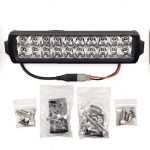You may be thinking that a string trimmer can only be used to edge your lawn. Actually, it can also be used to cut the grass in some areas of the lawn instead of using a lawnmower.
Many who have used a string trimmer on more than just edging prefer a straight shaft trimmer instead of a curved-shaft version. They say that the straight-shaft is easier to control and much more effective and it is said to be better under shrubs and small trees. Of course, what style of trimmer you prefer is really more of a subjective question.
Many users of a string trimmer have difficulty with the spin direction. A trimmer is similar to a chainsaw in that it needs to eject debris from its cut path. Trimmers that spin counterclockwise ejects debris from the left side and cuts best on the right side.
So, when moving along a walkway, curb, or fence, it is suggested that you keep the right side of the trimmer closer to the work so that the head of the tool can eject debris to the left. If you allow the debris to be ejected to the right, it is going into the cut path and there is nowhere for it to go. The remains pile up along the cut line, swamps the trimmer and makes scalping (or cutting too much of a blade of grass) unavoidable.
Cutting Methods
At first thought, it would appear that simply hovering the string trimmer above the grass and allowing the string to twirl, the grass will be cut to length. However, those in the know say that is not the best tactic and could result in serious scalping of the lawn.
There are a few techniques that the pros use that assure better control of the trimmer. The key is that the ends of the string are where the cutting power is. The faster and freer the ends swirl, the better for the life of the lawn.
Professionals in lawn care suggest that there are four techniques of cutting –-tapering, edging, scything, and screeding.
Tapering is performed near the edges of the lawn. In this case, you pitch the string tips of the trimmer toward the object you are trimming against. This permits the machine to cut less grass and leaves a tight, tapered edge. The style of cutting also blends the edge with the height of the mowed grass, which results in a cleaner appearance.
The edging technique is used in the parallel points between the grass and the driveway or walkway. It is suggested that you turn the trimmer so that the string is vertical and then walk it along the cut path so that debris is ejected where you cut. Don’t worry if you pull up dirt, rocks, or other debris while cutting in this method. If you are working on a lawn that hasn’t be edged before, then it is not necessary to try to cut a crisp edge all at once. Simply cut the lawn each week and slowly achieve the edge you want. Once you have a bona fide edge, maintaining it to remain that way is easy.
Whenever you trim against an obstruction you can’t easily walk around or if you have an area of your lawn where the grass is tall, then it is suggested you use the scything method. Move the head of the trimmer in a shallow U motion against the grass. Overlapping the scythes evens the cut.
Use the screeding method when cutting grass and weeds that are growing in the driveway, on paths, and between sidewalk cracks. Tip the trimmer so that the string tips are just glancing off the pavement and cut flush into the hard surface moving into the weed or grass base. Be careful. If you angle the tool too shallow, you’re just eating the string and not cutting effectively. If you angle it too sharp, then the string can’t hit enough of the grass or weed base to cut evenly.
(Source: Popular Mechanics.com)







